CHANCELLORSVILLE CAMPAIGN
April 27 to May 06, 1863
Lincoln appointed "Fighting Joe" Hooker to the command of the Army of the Potomac on
January 25, 1863. Hooker immediately set out to improve the welfare and morale of
the troops. He introduced corps insignia badges to give the men more pride in their
units. He also reorganized the Federal cavalry into a single corps of 11,500
troopers under the command of Brigadier General George Stoneman to better counter
the Southern cavalry superiority.
Hooker had more than 130,000 troops and 412 artillery pieces, more than twice the
strength of Lee in all three combat arms: infantry, cavalry, and artillery. He
intended to use these superior numbers to effect a plan whereby he would employ a
pincer movement against Lee. One half of the army would cross the Rappahanock River
below Fredericksburg and the other half would cross upstream to move against Lee's
rear. Each Federal wing would be almost the size of Lee's entire command. The
Federal cavalry meanwhile, would attempt to create confusion by operations behind
Lee's lines.
The new commander crafted a brilliant plan for the spring that he expected would at least compel General Robert E. Lee to abandon his Fredericksburg entrenchments, and, possibly, prove fatal to the Army of Northern Virginia. First, Hooker would detach his cavalry, 10,000 strong, on a flying raid toward Richmond to sever Lee's communications with the Confederate capital. Then, he would send most of his infantry 40 miles upstream to cross the Rappahannock and Rapidan Rivers beyond the Confederate defenses, and sweep east against Lee's left flank. The rest of "Fighting Joe's" army would cross the river at Fredericksburg and menace the Confederate front as the second blade of a great pincers. "My plans are perfect," boasted Hooker "and when I start to carry them out may God have mercy on General Lee, for I will have none."
The condition of the Confederate army lent credence to Hooker's confidence. In February, Lee detached his stalwart lieutenant, James Longstreet, with two strong divisions to gather food and supplies in southeastern Virginia. The gray commander cherished the offensive, but could not hope to move north without Longstreet. In the meantime, Lee's 60,000 veterans at Fredericksburg would guard their long river line against 130,000 well-equipped Yankees.
Bad weather prevented the execution of the plan until late April. Hooker initially
misled Lee as to his true intentions by leaving Gibbon's division in camp while
moving the rest of the army. Lee quickly discerned Hookers's true intentions
however. After watching Sedgwick's men consolidating their bridgehead below
Fredericksburg, Lee decided that the main threat was Hooker's flanking column. Lee
therefore moved the bulk of his army towards Hooker and left Major General Jubal
Early with about 10,000 men to contain Sedgwick.
Hooker began the campaign on April 27 and within three days some 40,000 Federals had splashed through the upriver fords, their presence detected by Confederate cavalry. On April 29, a sizable Union force led by Maj. Gen. John Sedgwick's Sixth Corps erected pontoon bridges below Fredericksburg and also moved to Lee's side of the river.
With both wings of the enemy across the Rappahannock, Lee faced a serious dilemma.
Conventional military wisdom dictated that the understrength Army of Northern Virginia retreat south and escape Hooker's trap. Lee opted instead to meet the Federal challenge head-on. Correctly deducing that Hooker's primary threat lay to the west, "Marse Robert" assigned 10,000 troops under Maj. Gen. Jubal A. Early to man the old Fredericksburg entrenchments. The balance of the army would turn west toward the tangled Wilderness to confront Hooker's flanking column.
By midafternoon of April 30, that column, now containing 50,000 men and 108 artillery pieces, rendezvoused at the most important road junction in the Wilderness. A large brick tavern named Chancellorsville dominated this intersection of the Orange Turnpike with the Orange Plank, Ely's Ford, and River roads. "This is splendid," exulted one of Hooker's corps commanders, "Hurrah for Old Joe."
The Federals had encountered virtually no opposition to this point. Moreover, they could now press eastward, break clear of the Wilderness, and uncover Banks Ford downstream, thus significantly shortening the distance between their two wings. Hooker, however, decided to halt at Chancellorsville and await the arrival of additional Union troops. This fateful decision disheartened the Federal officers on the scene who recognized the urgency of maintaining the momentum they had thus far sustained.
"Stonewall" Jackson, gladly seizing the initiative that Hooker needlessly surrendered, left the Fredericksburg lines at 3:00 a.m, on May 01 and arrived at Zoan Church five hours later. There he found two divisions of Confederate infantry, Maj. Gen. Richard H. Anderson's and Maj. Gen. Lafayette McLaws', fortifying a prominent ridge covering the Turnpike and Plank Road. Although his corps had not yet appeared, Jackson ordered Anderson and McLaws to drop their shovels, pick up their rifles, and advance to the attack. See Anderson's and McLaws' Official Reports on the battle.
Jackson's audacity dictated the shape of the Battle of Chancellorsville. When Hooker at last authorized an eastward movement late in the morning of May 1, his troops on the Turnpike and Plank Road ran flush against "Stonewall's", outgunned but aggressive brigades. Union front-line commanders had not expected this kind of resistance. They sent anxious messages to Hooker, who quickly ordered his generals to fall back to the Wilderness and assume a defensive posture. The Federal columns on the River Road marched almost to Bank's Ford without seeing a Rebel. They returned to Chancellorsville fuming, fully realizing the opportunity
that had slipped through their fingers. See A. P. Hill's Official Report for Jackson's Corps.
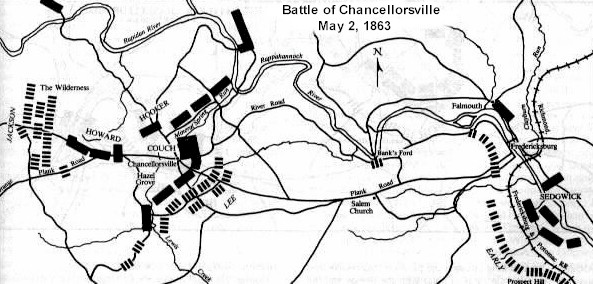 Late in the day, as the blue infantry threw up entrenchments encircling Hooker's Chancellorsville headquarters, Maj. Gen. Darius N. Couch approached his superior. As the army's senior corps commander, Couch had advocated an offensive strategy and shared his comrades' disappointment with "Fighting Joe's" judgment. "It is all right, Couch," Hooker reassured him, "I have got Lee just where I want him; he must fight me on my own ground."
Late in the day, as the blue infantry threw up entrenchments encircling Hooker's Chancellorsville headquarters, Maj. Gen. Darius N. Couch approached his superior. As the army's senior corps commander, Couch had advocated an offensive strategy and shared his comrades' disappointment with "Fighting Joe's" judgment. "It is all right, Couch," Hooker reassured him, "I have got Lee just where I want him; he must fight me on my own ground."
Couch could barely believe his ears. "To hear from his own lip that the advantages gained by the successful marches of his lieutenants were to culminate in fighting a defensive battle in that nest of thickets was too much, and I retired from his presence with the belief that my commanding general was a whipped man."
Hooker's confidence had faded to caution, but whether he was "whipped" depended upon Lee and Jackson. Those two officers reined up along the Plank Road at its intesection with a byway call the Furnace Road on the evening of May 1. Transforming discarded Federal cracker boxes into camp stools, the generals examined their options.
Confederate scouts verified the Federals' strong positions extending from the Rappahannock River, around Chancellorsville, to the high, open ground at Hazel Grove. This was the bad news. The Southern army couldn not afford a costly frontal attack against prepared fortifications.
Then, about midnight, Lee's cavalry chief, "Jeb" Stuart, galloped up to the little campfire. The flamboyant Virginian carried thrilling intelligence. The Union right flank was "in the air" -- that is, resting on no natural or artificial obstacle! From that moment on, the generals thought of nothing but how to gain access to Hooker's vulnerable flank. Jackson consulted with staff officers familiar with the area, dispatched his topographical engineer to explore the roads to the west, and tried to snatch a few hours rest at the chilly bivouac.
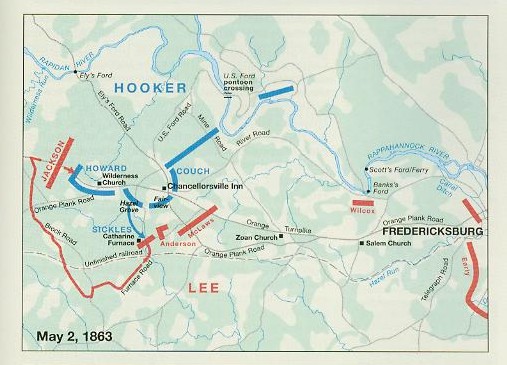 Before dawn, Lee and Jackson studied a hastily drawn map and decided to undertake one of the biggest gambles in American military history. Jackson's corps, about 30,000 troops, would follow a series of country roads and woods paths to reach the Union right. Lee, with the remaining 14,000 infantry, would occupy a position more than three miles long and divert Hooker's attention during Jackson's dangerous trek. Once in position, "Stonewall" would smash the Federals with his full strength while Lee cooperated as best he could. The Army of Northern Virginia would thus be fractured into three pieces, counting Early's contingent at Fredericksburg, any one of which might be subject to rout or annihilation if the Yankees resumed the offensive.
Before dawn, Lee and Jackson studied a hastily drawn map and decided to undertake one of the biggest gambles in American military history. Jackson's corps, about 30,000 troops, would follow a series of country roads and woods paths to reach the Union right. Lee, with the remaining 14,000 infantry, would occupy a position more than three miles long and divert Hooker's attention during Jackson's dangerous trek. Once in position, "Stonewall" would smash the Federals with his full strength while Lee cooperated as best he could. The Army of Northern Virginia would thus be fractured into three pieces, counting Early's contingent at Fredericksburg, any one of which might be subject to rout or annihilation if the Yankees resumed the offensive.
Jackson led his column past the bivouac early on the morning of May 2. He conferred briefly with Lee, then trotted down the Furnace Road with the fire of battle kindled in his eyes. After about one mile, as the Confederates traversed a small clearing, Union scouts perched in treetops at Hazel Grove spotted the marchers. The Federals lobbed artillery shells at Jackson's men and notified Hooker of the enemy movement.
"Fighting Joe" correctly identified Jackson's maneuver as an effort to reach his right flank. He advised the area commander, Maj. Gen. Oliver 0. Howard, to be on the lookout for an attack from the west. As the morning progressed, however, the Union chief grew to believe that Lee was actually withdrawing - the course of events Hooker most preferred. Worries about his right disappeared. Instead, he ordered his Third Corps to harass the tail end of Lee's "retreating" army.
Colorful Maj. Gen. Daniel E. Sickles commanded the Third Corps. He probed cautiously from Hazel Grove toward a local iron manufactory called Catharine Furnace. In mid-afternoon the Federals overwhelmed Jackson's rearguard beyond the furnace along the cut of an unfinished railroad, capturing nearly an entire Georgia regiment. The action at Catharine Furnace, however, eventually attracted some 20,000 Bluecoats onto the scene thus effectively isolating Howard's Eleventh Corps on the right with no nearby support.
Meanwhile the bulk of Jackson's column snaked its way along uncharted trails barely wide enough to accommodate four men abreast. "Stonewall" contributed to Hooker's faith in a Confederate retreat by twice turning away from the Union line - first at Catharine Furnace, then again at the Brock Road. After making the desired impression, Jackson ducked under the Wilderness canopy and continued his march toward Howard's insensible soldiers.
Acting upon a personal reconnaissance recommended by cavalry General Fitzhugh Lee, Jackson kept his column northbound on the Brock Road to the Orange Turnpike where the Confederates would at last be beyond the Union right. The exhausting march, which altogether traversed more, than 12 miles, ended about 3 p.m. when "Old Jack's" warriors began deploying into battle lines astride the Turnpike. Jackson, however, did not authorize an attack for some tow hours, providing 11 of his 15 brigades time to take position in the silent forest. The awe-inspiring Confederate front measured nearly two miles across.
Although individual Northern officers and men warned of Jackson's approach, Eleventh Corps headquarters dismissed the reports as frightened expaggerations from alarmists or cowards. Hooker's shortage of cavalry hampered the Federals's ability to penetrate the Wilderness and uncover the Confederate presence with certainty. Only two small regiments and half a New York battery faced west in the direction of Jackson's corps.
Suddenly, a bugle rang out in the afternoon shadows. Bugles everywhere echoed the notes up and down the line. As waves of sweat-soaked soldiers rolled forward, the high defiance of the Rebel Yell pierced the gloomy woods. Jackson's Corps erupted from the trees and sent the astonished Unionists reeling. "Along the road it was pandmonium," recalled a Massachusetts soldier, "and on the side of the road it was chaos."
Most of Howard's men fought bravely, drawing three additonal battle lines across Jackson's path. But the overmatched Federals occupied an untenable position. The screaming gray legions overwhelmed each Union stand and eventually drove the Eleventh Corps completely from the field.
Sunset and the inevitable intermingling of "Stonewall's" brigades compelled Jackson to call a reluctant halt to the advance about 7:15. He summoned Maj. Gen. A.P. Hill's division to the front and, typically, determined to renew his attack despite the darkness. Jackson hoped to maneuver between Hooker and his escape routes across the rivers and then, with Lee's help, grind the Army of the Potomac into oblivion.
While Hill brought his brigades forward, Jackson rode ahead of his men to reconnoiter. When he attempted to return, a North Carolina regiment mistook his small party for Union cavalry. Two volleys burst forth in the blackness and Jackson tottered in his saddle, suffering from three wounds. Shortly thereafter a Federal shell struck Hill, incapacitating him, and direction of the corps devolved upon Stuart. The cavalryman wisely cancelled "Stonewall's" plans for a night attack.
Despite his misfortune on May 2, Hooker still held the advantage at Chancellorsville. He received reinforcements during the night and the Third Corps moved back from Catharine Furnace to reoccupy Hazel Grove. Sickles' troops thus divided the Confederates into separate wings controlled by Stuart and Lee. Hooker, if he chose, could defeat each fraction of his outmanned enemy in detail.
The Confederate commanders understood the need to connect their divisions, and Stuart prepared an all-out assault against Hazel Grove at dawn. Hooker made it easy for him. As the Southerners approached the far crest of Hazel Grove they witnessed Sickles' men retiring in an orderly fashion. "Fighting Joe" had directed that his troops surrender the key ground and fall back to Fairview, an elevated clearing closer to Chancellorsville.
Stuart immediately exploited the opportunity by placing 31 cannon on Hazel Grove. Combined with artillery located west along the Turnpike, the gunners at Hazel Grove pounded Fairview with a spectacular bombardment. The Federals responded with 34 pieces of their own and soon the Wilderness trembled with a discordant symphony of iron.
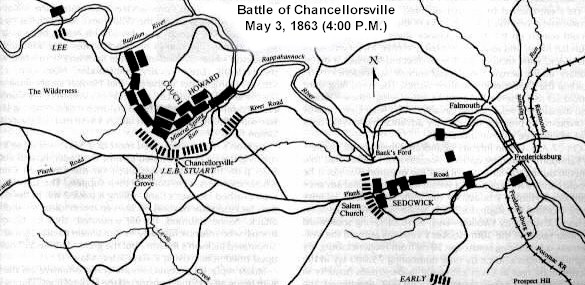 The bloodiest fighting of the battle occurred between 6:30 and 9:30 a.m. on May 3. Stuart launched brigade after brigade against entrenched Union lines on both sides of the Turnpike. Troops lost their way in the tangled underbrush and the woods caught fire, confronting the wounded with a horrible fate.
The bloodiest fighting of the battle occurred between 6:30 and 9:30 a.m. on May 3. Stuart launched brigade after brigade against entrenched Union lines on both sides of the Turnpike. Troops lost their way in the tangled underbrush and the woods caught fire, confronting the wounded with a horrible fate.
The see-saw fighting began to favor the Southerners as, one by one, Union artillery pieces dropped out of the contest. Hooker failed to resupply his cannoneers with ammunition or shift sufficient infantry reserves to critical areas. A Confederate projectile abetted this mental paralysis when it struck a pillar at Chancellorsville, throwing the Union commander violently to the ground. The impact stunned Hooker, physically removing him from a battle in which he had not materially been engaged for nearly 48 hours. Before relinquishing partial authority to Couch, Hooker instructed the army to assume a prepared position in the rear, protecting the bridgehead across the Rappahannock.
Stuart pressed forward first to Fairview and then against the remaining Union units at Chancellorsville. Lee's wing advanced simultaneously from the south and east. The Bluecoats receded at last and thousands of powder-smeared Confederates poured into the clearing, illuminated by flames from the burning Chancellorsville mansion.
Lee emerged from the smoke and elicited a long, unbroken cheer from the gray multitudes who recognized him as the architect of their improbable victory. A Confederate staff officer, watching the unbridled expression of so much admiration, reverence, and love, thought that, "it must have been
from such a scene that men in ancient times rose to the dignity of gods."
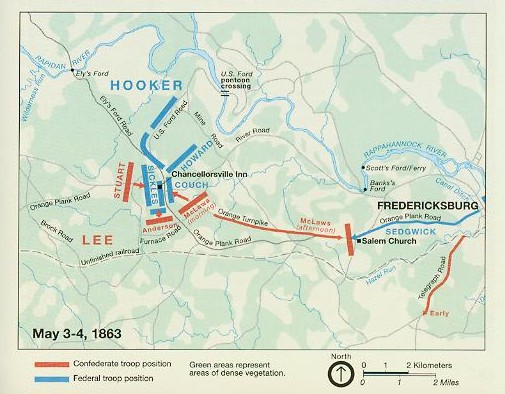 The Southern commander wasted little time on reflection. He prepared to pursue Hooker and seal the success achieved since dawn. A courier bearing news from Fredericksburg shattered Lee's plans. Sedgwick had driven Early's contingent from Marye's Heights and now threatened the Confederate rear. This changed everything. Lee assigned Stuart to watch Hooker's host and sent McLaws eastward to deal with the Sixth Corps menace.
The Southern commander wasted little time on reflection. He prepared to pursue Hooker and seal the success achieved since dawn. A courier bearing news from Fredericksburg shattered Lee's plans. Sedgwick had driven Early's contingent from Marye's Heights and now threatened the Confederate rear. This changed everything. Lee assigned Stuart to watch Hooker's host and sent McLaws eastward to deal with the Sixth Corps menace.
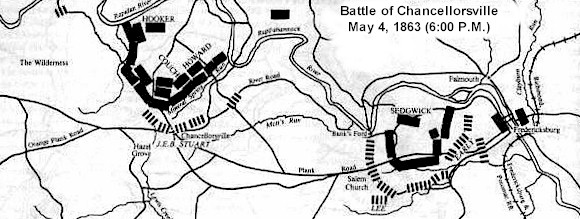 Sedgwick, slowed by Wilcox's single Alabama brigade retreating stubbornly from Fredericksburg, came to grips with the Confederates four miles west of town at Salem Church. The Federals swept into the churchyard but a powerful counterattack drove them back and ended the day's combat. The next day Lee shoved Sedgwick across the Rappahannock at Banks Ford and once again focused on the main Union army in the Wilderness.
Sedgwick, slowed by Wilcox's single Alabama brigade retreating stubbornly from Fredericksburg, came to grips with the Confederates four miles west of town at Salem Church. The Federals swept into the churchyard but a powerful counterattack drove them back and ended the day's combat. The next day Lee shoved Sedgwick across the Rappahannock at Banks Ford and once again focused on the main Union army in the Wilderness.
Hooker, however, had seen enough. Despite the objections of most of his corps commanders, he ordered a withdrawal across the river. The Federals conducted their retreat under cover of darkness and arrived back in Stafford County on May 6. Ironically, this decision may have been Hooker's most serious blunder of the campaign. Lee's impending assault on May 6 might have failed and completely reversed the outcome of the battle.
==================
SUMMARY
==================
Confederate leadership during the Chancellorsville Campaign may represent the finest generalship of the Civil War, but the luster of "Lee's greatest victory" tarnishes upon examination of the battle's tangible results. In truth, the Army of the Potomac had not been so thoroughly defeated - some 40,000 Federals had done no fighting whatsoever. Although Hooker suffered more than 17,000 casualties, those losses accounted for only 13% of his total strength. Lee's 13,000 casualties amounted to 22% of his army, men difficult to replace. Of course, Jackson's death on May 10 created a vacancy that could never be filled.
Finally, Lee's triumph at Chancellorsville imbued him with the belief that his army was invincible. He convinced the Richmond government to endorse his proposed offensive into Pennsylvania. Within six weeks, the Army of Northern Virginia confidently embarked on a journey northward to keep an appointment with destiny at a place called Gettysburg.
Sources:
A. Wilson Green, Staff Historian
National Park Service Training Booklet
Fredericksburg and Spotsylvania National Military Park
National Park Service
Edward J. Stackpole
Chancellorsville, Lee's Greatest Battle
The Stackpole Company
Harrisburg, Pennsylvania, 1958

THE BEGINING
April 26 - May 1, 1863
April 26: Federal I and VI Corps cross the river and demonstrate against Lee's
Fredricksburg defenses
April 27: Federal V, XI and XII Corps concentrate, preparing to move upriver.
April 29: Federals cross, Kelly's Ford against slight opposition before splitting
their columns.
April 29: Meade's V Corps secures Ely's Ford during the evening.
April 29: Howard's XI Corps and Slocomb's XII Corps cross Germanna's Ford during the
evening.
April 30: Sykes Division of V Corps uncovers U.S. Ford for the two Federal corps to
cross.
April 30: Hooker reunites, the right wing of the Army of the Potomac.
April 30: J.E.B. Stuart's Confederate cavalry clings to the Federal column, sending
Lee information as to its strength.
April 30 - May 1: Lee divides his army, leaving Early at Fredricksburg while the
remainder move toward Chancellorsville.
THE END
May 1-6, 1863
May 1, pm: Hooker's Federal army assumes a strong defensive position around the west of Chancellorsville.
May 1,late pm: Lee receives news that Hooker's right is weak, and plans an attack
with Jackson for May 2.
May 2, 7:00 am-5:00 pm: Jackson marches 27,000 troops around Hooker while Lee keeps
pressure on the Federals with the remaining 13,000.
May 2, 12:00 Noon-5:00pm: Sickles III Corps attempts to attack Jackson's column but
tangles with Lee's force instead.
May 2, 5:15pm: Jackson routs the Union XI Corps with a surprise attack.
May 2, 9:30pm: Jackson is accidentally shot by his own troops command passes to
J.E.B Stuart.
May 3, 5:00-10:00am: Lee and Stuart reunite after a desperate morning of punishing
frontal attacks.
May 3, 12:30pm: Lee is diverted from attacking Hooker's last line by an urgent
message from Early at Fredericksburg.
May 3-4: Lee blocks Federal advance and counterattacks. Meanwhile, 4 miles east,
Sedgwick's VI Corps captures Early's defenses and set out for
Chancellorsville.
May 6: Hooker retreats across the river before Lee can attack.
Sources:
Robert N. Scott, Bvt. Lieutenant Colonel, Third US Artillery, Under direction of
the Secretary of War
The War of the Rebellion: A Compilation of the Official Records of the Union and
Confederata Armies
Washington Goverment Printing Office. Published pursuant to Act of Congress
Approved June 16, 1880
Washington, DC, 1880
Edward J. Stackpole
Chancellorsville, Lee's Greatest Battle
The Stackpole Company
Harrisburg, Pennsylvania, 1958
Last Updated 12 May 2002

It was the best of times, it was the worst of times
Click on any [Item] below to go to that page
[Return to Glossary Page]
[Return to 43rd Pennsylvania Home Page]

© 1998-2004 Benjamin M. Givens, Jr.

 Late in the day, as the blue infantry threw up entrenchments encircling Hooker's Chancellorsville headquarters, Maj. Gen. Darius N. Couch approached his superior. As the army's senior corps commander, Couch had advocated an offensive strategy and shared his comrades' disappointment with "Fighting Joe's" judgment. "It is all right, Couch," Hooker reassured him, "I have got Lee just where I want him; he must fight me on my own ground."
Late in the day, as the blue infantry threw up entrenchments encircling Hooker's Chancellorsville headquarters, Maj. Gen. Darius N. Couch approached his superior. As the army's senior corps commander, Couch had advocated an offensive strategy and shared his comrades' disappointment with "Fighting Joe's" judgment. "It is all right, Couch," Hooker reassured him, "I have got Lee just where I want him; he must fight me on my own ground."
 Before dawn, Lee and Jackson studied a hastily drawn map and decided to undertake one of the biggest gambles in American military history. Jackson's corps, about 30,000 troops, would follow a series of country roads and woods paths to reach the Union right. Lee, with the remaining 14,000 infantry, would occupy a position more than three miles long and divert Hooker's attention during Jackson's dangerous trek. Once in position, "Stonewall" would smash the Federals with his full strength while Lee cooperated as best he could. The Army of Northern Virginia would thus be fractured into three pieces, counting Early's contingent at Fredericksburg, any one of which might be subject to rout or annihilation if the Yankees resumed the offensive.
Before dawn, Lee and Jackson studied a hastily drawn map and decided to undertake one of the biggest gambles in American military history. Jackson's corps, about 30,000 troops, would follow a series of country roads and woods paths to reach the Union right. Lee, with the remaining 14,000 infantry, would occupy a position more than three miles long and divert Hooker's attention during Jackson's dangerous trek. Once in position, "Stonewall" would smash the Federals with his full strength while Lee cooperated as best he could. The Army of Northern Virginia would thus be fractured into three pieces, counting Early's contingent at Fredericksburg, any one of which might be subject to rout or annihilation if the Yankees resumed the offensive.
 The bloodiest fighting of the battle occurred between 6:30 and 9:30 a.m. on May 3. Stuart launched brigade after brigade against entrenched Union lines on both sides of the Turnpike. Troops lost their way in the tangled underbrush and the woods caught fire, confronting the wounded with a horrible fate.
The bloodiest fighting of the battle occurred between 6:30 and 9:30 a.m. on May 3. Stuart launched brigade after brigade against entrenched Union lines on both sides of the Turnpike. Troops lost their way in the tangled underbrush and the woods caught fire, confronting the wounded with a horrible fate.
 The Southern commander wasted little time on reflection. He prepared to pursue Hooker and seal the success achieved since dawn. A courier bearing news from Fredericksburg shattered Lee's plans. Sedgwick had driven Early's contingent from Marye's Heights and now threatened the Confederate rear. This changed everything. Lee assigned Stuart to watch Hooker's host and sent McLaws eastward to deal with the Sixth Corps menace.
The Southern commander wasted little time on reflection. He prepared to pursue Hooker and seal the success achieved since dawn. A courier bearing news from Fredericksburg shattered Lee's plans. Sedgwick had driven Early's contingent from Marye's Heights and now threatened the Confederate rear. This changed everything. Lee assigned Stuart to watch Hooker's host and sent McLaws eastward to deal with the Sixth Corps menace.
 Sedgwick, slowed by Wilcox's single Alabama brigade retreating stubbornly from Fredericksburg, came to grips with the Confederates four miles west of town at Salem Church. The Federals swept into the churchyard but a powerful counterattack drove them back and ended the day's combat. The next day Lee shoved Sedgwick across the Rappahannock at Banks Ford and once again focused on the main Union army in the Wilderness.
Sedgwick, slowed by Wilcox's single Alabama brigade retreating stubbornly from Fredericksburg, came to grips with the Confederates four miles west of town at Salem Church. The Federals swept into the churchyard but a powerful counterattack drove them back and ended the day's combat. The next day Lee shoved Sedgwick across the Rappahannock at Banks Ford and once again focused on the main Union army in the Wilderness.
